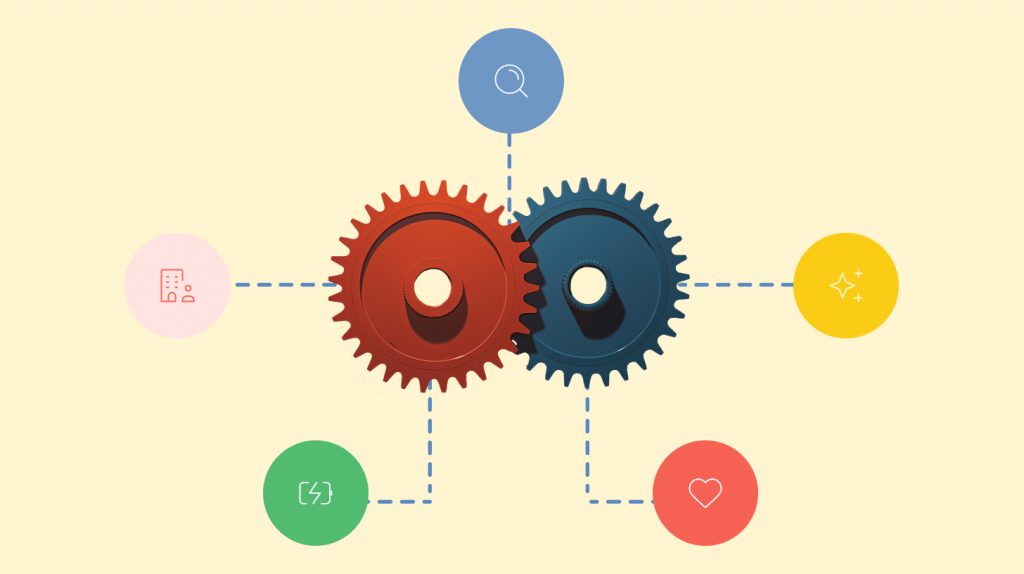Understanding and effectively managing the employee life cycle is essential for HR professionals striving for an optimal company culture. From attraction to offboarding, each stage of the employee life cycle significantly shapes an employee’s perception of and performance at your organization.
The employee life cycle serves as a framework for strategically planning and executing key activities at specific moments during an employee’s tenure. These activities improve their experience, align with company values, and ultimately offer insights on how to optimize your HR practices down the road.
In this article, we take you through the intricacies of each stage of the employee life cycle. By implementing these HR process steps, you’ll optimize talent acquisition, nurture employee development, boost retention rates, and achieve a smooth transition when employees leave your organization.
What is the Employee Life Cycle?
The employee life cycle is a journey that employees embark on from the moment they join your organization until the day they leave. It’s a series of stages that guide HR professionals in managing and optimizing the employee experience. As employees embark on their lifecycle at your company, they evolve and grow within the organization, contributing their skills, talents, and passion along the way.
At its core, the employee life cycle SHRM recognizes that employees are not static resources, but dynamic individuals with evolving needs and aspirations. It acknowledges that their journey is not limited to a mere job title, but a holistic experience that encompasses their interactions, growth opportunities, and overall well-being within your organization.
For HR professionals, this offers an opportunity to positively contribute to the right activities and interactions at the right times during an employee’s evolution. In essence, it improves their experience at the company and optimizes their performance.
The 6 Stages of the Employee Life Cycle

From attracting and recruiting talent in the initial stage to gracefully transitioning employees out of an organization, each stage plays a vital role in shaping your employee experience.
Below, we’ll examine the attraction, recruitment, onboarding, development, engagement, and transition stages, demonstrating the strategies and approaches that you can use to make the most of each phase of the employee journey.
1. Attraction: attracting top talent
As the name implies, this HR stage is where you try to capture applicants interested in your job openings and your company’s mission.
An excellent way to attract top talent is to develop a good employer branding strategy tied to your company values. According to Glassdoor, 86% of job seekers check for company ratings and reviews before applying. In other words, how the public perceives your organization matters, whether it’s an accurate perception or not. However, you can enhance your reputation by implementing fringe benefits, policies, and programs that stimulate employee engagement and retention.
For example, offering employee financial wellness programs demonstrates interest in employees’ well-being. This encourages workers to remain with your company and even spread the word about your organization to their network. Ultimately, it strengthens your company’s reputation and attracts top talent to apply when word goes out that you’re hiring.
Read next: Is Your Business Prepared to Work With Gen Z and Gen Alpha?
2. Recruitment: selecting the best candidates
Now that you’ve attracted top candidates, it’s time to select the best among them. The recruitment stage is where it all begins. It’s the quest for finding that exceptional talent who will go above and beyond in contributing to your organization’s goals. This stage involves identifying talent needs, creating job postings and application processes, sourcing candidates, conducting screening interviews, and ultimately selecting the best fit for the role.
In a competitive talent market, recruiting top talent goes beyond posting job listings on online platforms. It also requires a strong online presence, and an authentic company culture that resonates with potential candidates. HR professionals leverage creative strategies, such as employer branding campaigns, employee referral programs, and active networking, to cast a wide net and draw in top-notch talent before sifting through the numbers.
Learn more: What to Include in an Employment Contract
3. Onboarding: igniting the spark
Imagine the first day at a new job—a mix of excitement, curiosity, and perhaps more than a few nerves. The onboarding process is all about transforming that initial spark of interest into a fire of engagement and commitment. It’s about welcoming new employees into your organization, helping them navigate their roles and responsibilities, and creating connections with their teams and the larger company culture.
But it’s not just about paperwork and orientation sessions. Forward-thinking organizations infuse a touch of fun and personalization into their onboarding process. For instance, you can assign a buddy or mentor to guide new hires, organize team-building activities, or host informal welcome events. These gestures create a warm and inclusive environment, making new employees feel like they’re part of something special from day one.
But onboarding can be demanding, especially as it involves repetitive tasks like scheduling meetings and regular training. A pro tip to optimize the process is to invest in HR automation. It provides a consistent and efficient onboarding process. For example, when your organization gets a new hire, HR workflows automatically create a profile for the new employee in your HRIS and welcome them with employee handbooks and other training materials within the system.
4.. Development: nurturing growth and potential
As employees settle into their roles, development takes center stage. This phase focuses on providing ongoing learning opportunities, professional growth, and skill enhancement to ensure employees are equipped with the knowledge and tools they need to thrive in their positions.
Development initiatives will take various forms, including training programs, workshops, conferences, mentorship programs, and stretch assignments. Your organization should encourage continuous learning and offer development paths tailored to individual aspirations and organizational needs. This helps to motivate employees and empowers them to expand their capabilities while fostering a culture of innovation and adaptability.
5. Engagement: cultivating connection and motivation
Employee engagement is the lifeblood of a thriving organization. This stage recognizes that engaged employees are more efficient, loyal, and invested in their work. It’s about creating an environment where employees feel valued, connected, and motivated to give their best each day.
Organizations cultivate engagement by building a positive work culture, recognizing and rewarding achievements, encouraging open communication and collaboration, and promoting work-life balance. They create opportunities for employees to contribute their ideas, take ownership of projects, and participate in decision-making processes. By prioritizing employee well-being and providing a supportive work environment, organizations can nurture a sense of belonging and drive and mitigate chances of employee burnout.
Want more engagement ideas?
6. Transition: offboarding with grace
The employee life cycle comes to a close with the transition stage. It’s the bittersweet farewell as employees move on to new opportunities or enter retirement. While it may seem counterintuitive to focus on offboarding, it’s a crucial stage for organizations to maintain positive relationships and uphold their employer brand.
During the offboarding process, HR professionals conduct exit interviews, collect feedback, and ensure a smooth transition of responsibilities. Organizations with a thoughtful offboarding approach provide support to departing employees, celebrate their contributions, and offer resources for future career endeavors. This sends a powerful message to remaining employees and external stakeholders about the organization’s commitment to treating employees with respect and dignity throughout their journey.
Tools for Employee Life Cycle Management
To streamline employee life cycle management, HR professionals should leverage available tools and technology. While it still begins with the humble spreadsheet, there’s a lot more to pack into your HR toolkit.
From all-in-one solutions like Omni, comprehensive HRIS platforms, and performance management systems, these tools empower organizations to streamline their processes, enhance employee engagement, and drive success in the modern workplace.
Spreadsheets: Spreadsheets have long been a go-to tool for HR professionals managing various aspects of the employee life cycle. They offer flexibility and customization, allowing HR teams to create trackers for recruitment, onboarding, performance evaluations, and more.
That said, spreadsheets can be time-consuming and prone to errors, especially as your organization grows and the volume of employee data increases. They lack the automation and centralized access that dedicated employee life cycle management tools provide.
Human Resources Information Systems (HRIS): HRIS platforms are comprehensive software solutions designed to streamline and automate HR processes throughout the employee life cycle. They offer a wide range of functionalities, including applicant tracking, employee data management, benefits administration, performance management, and offboarding. HRIS platforms centralize data, improve data accuracy, and enable efficient reporting and analytics.
Performance management systems: Performance management systems play a critical role in the development and engagement stages of the employee life cycle. These systems enable organizations to set goals, track progress, provide feedback, and conduct performance evaluations.
They often include features such as goal setting, real-time feedback, competency assessments, and performance dashboards. However, some performance management systems may lack integration with other HR processes, resulting in disjointed data and manual data entry.
Employee engagement platforms: Employee engagement platforms are tools designed to measure and improve employee engagement throughout the employee life cycle. These platforms offer employee satisfaction surveys, pulse checks, feedback mechanisms, and communication tools to gauge employee sentiment, gather feedback, and create a culture of continuous improvement.
They also provide insight into employee satisfaction, identify areas of improvement, and facilitate two-way communication between employees and management.
While employee engagement platforms are great tools to aid in performance management and engagement, they only cover one portion of the employee lifecycle, requiring HR teams to leverage additional software or tools to encompass the full employee lifecycle.
Champion Your Employee Life Cycle Management with Omni

Managing the employee life cycle is a fundamental responsibility for all HR professionals. By understanding the different stages and their goals, and accessing the right tools, HR teams can effectively attract, engage, develop, retain, and offboard employees.
Omni is a comprehensive HRIS for managing the entire end-to-end employee life cycle. With Omni, you can streamline recruitment, automate onboarding tasks, track employee development, drive engagement, manage payroll, and ensure a smooth offboarding experience all in one easy to use tool.
Our all-in-one solution offers features like secure document management, performance evaluations, employee surveys, and time management. Omni reduces administrative burden, enhances data accuracy, and fosters a seamless employee experience.
Omni empowers HR teams to optimize the employee life cycle by harnessing the power of automation, you’ll be able revolutionize your employee life cycle management, all while enhancing engagement, productivity, and overall organizational success.
The employee life cycle isn’t a one-size-fits-all model, and the specific needs and challenges will vary for each organization. Take the time to assess your organization’s requirements, explore the available tools, and choose those that align with your goals and values.
Ready to find success at every stage of your employees’ journeys?


